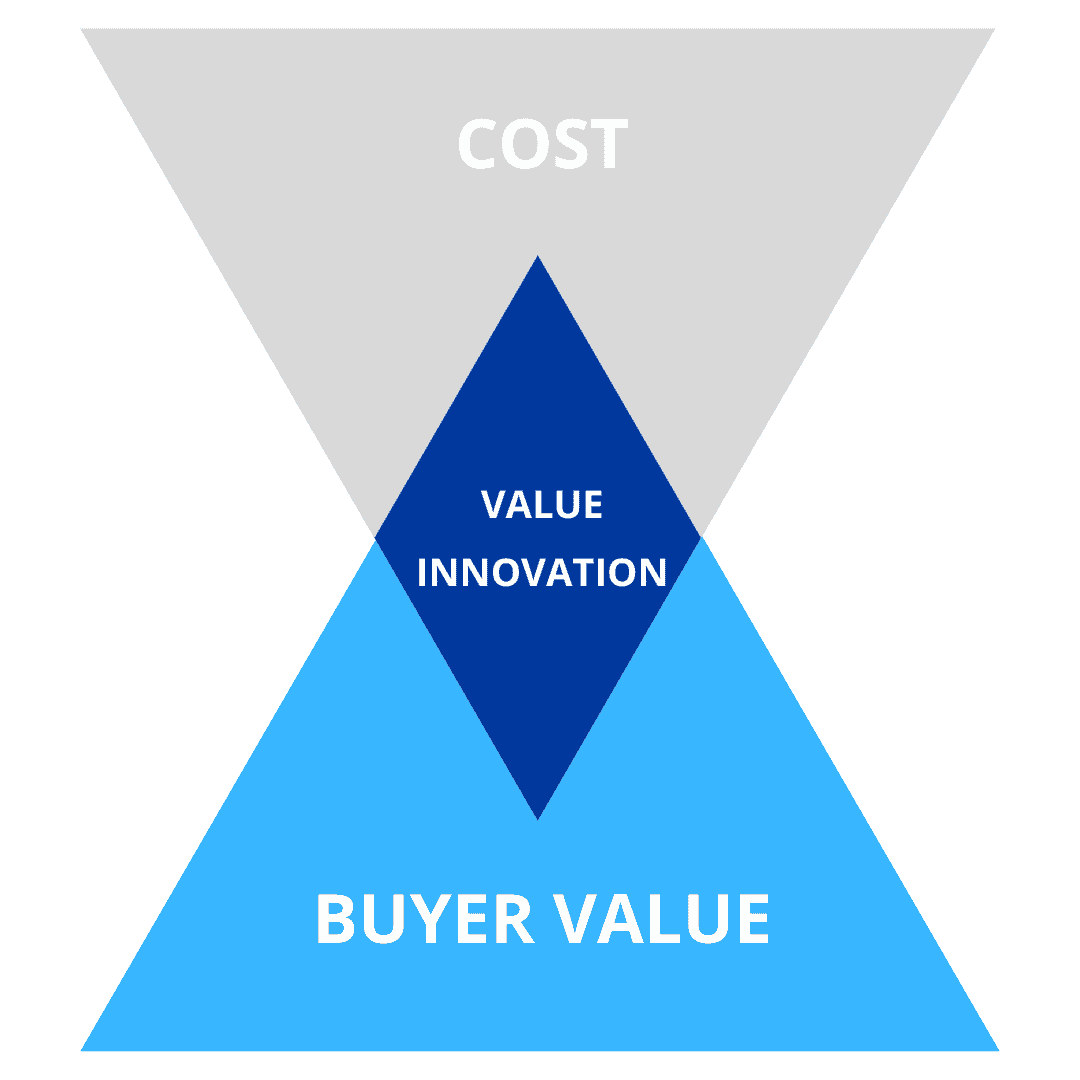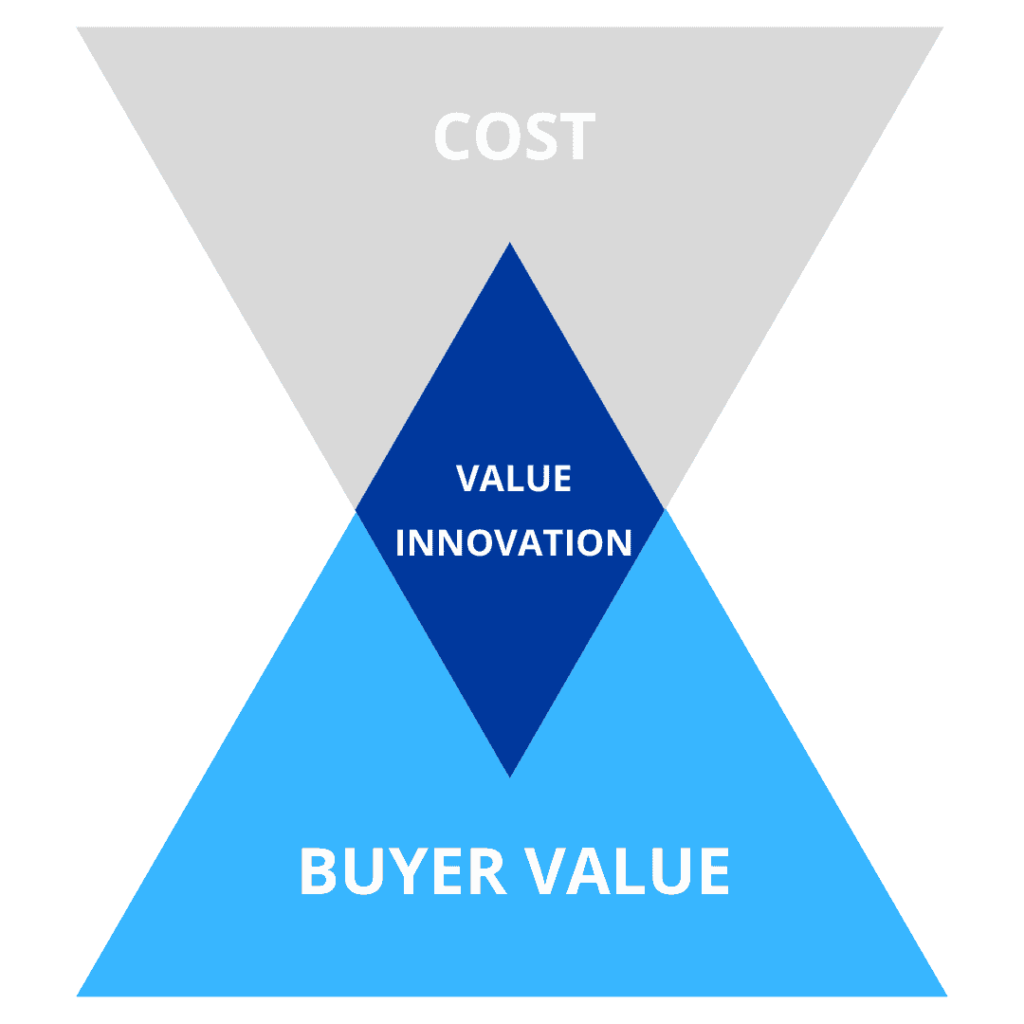Value innovation creates new value for the company and its customers by breaking away from traditional competitive strategies. Instead of focusing on outperforming rivals, value innovation seeks to deliver superior value at a lower cost, creating a leap in value that can generate entirely new markets or reshape existing ones.
The value innovation approach differs from common market strategies, which often prioritize either differentiation (offering premium products at higher costs) or cost leadership (offering lower-cost products at reduced quality).
In contrast, this strategy blends both elements, offering groundbreaking products or services that defy the usual trade-offs between value and cost.
Value innovation is a key concept within the Blue Ocean Strategy, a business framework introduced by W. Chan Kim and Renée Mauborgne. The strategy advocates for creating new market spaces—referred to as “blue oceans”—where competition is irrelevant rather than competing in crowded and oversaturated markets (“red oceans”). At the heart of the blue ocean strategy lies value innovation, which is about simultaneously pursuing differentiation and low cost to unlock new demand and make the competition obsolete.

Different from Common Market Strategies/Methods
Traditional market strategies often revolve around outperforming competitors by either undercutting prices or improving product features. However, value innovation challenges this zero-sum thinking. It rejects the belief that companies must either choose between differentiation and low cost, arguing that both can be achieved simultaneously.
Instead of competing head-to-head in existing markets, value innovation creates new opportunities where competition becomes irrelevant, driving growth through new value propositions.
How to Get Started with Value Innovation
To create value innovation, businesses must rethink their strategies by offering customers a significant leap in value while lowering costs. The Four Actions Framework is a central tool for achieving this, which helps companies break away from traditional competitive practices. This framework poses four key questions that guide companies in reshaping their approach to value creation:
- Eliminate: Which factors that the industry takes for granted should be eliminated?
- Reduce: Which factors should be reduced well below the industry standard?
- Raise: Which factors should be raised well above the industry standard?
- Create: What factors should be created that the industry has never offered?
By answering these questions, businesses can systematically challenge industry norms, cut unnecessary costs, and innovate in ways that add real value for customers.
This process helps firms break free from the competitive pressures of existing markets and unlock new demand by offering products or services that provide exceptional value without the trade-offs between cost and differentiation. The result is a “blue ocean” where competition is irrelevant, and companies can thrive by being unique rather than simply better.
Why Value Innovation
Value innovation is a powerful strategy that helps companies break away from traditional competition by creating new, uncontested market spaces. Unlike incremental improvements, which often only provide short-term advantages, value innovation focuses on providing both greater value to customers and lowering costs. This approach is essential for companies aiming to achieve long-term success without constantly battling competition in overcrowded markets.
Make the Competition Irrelevant
Instead of engaging in head-to-head competition, companies focus on delivering superior value at a lower cost, which opens up new market spaces.
Achieve Cost Savings
A significant advantage of value innovation is reducing costs while simultaneously offering higher value to customers. Companies achieve this by eliminating unnecessary features and reducing costs in areas that don’t align with customer priorities. By strategically cutting excess and refocusing on core customer needs, companies can maintain profitability while offering great value.
Foster an Exponential Mindset
Value innovation promotes exponential thinking, pushing companies to aim for breakthroughs rather than minor improvements. Traditional strategies often focus on incremental gains, like improving a product by 10%, while value innovation encourages businesses to consider being 10x better by offering something fundamentally different.
Examples of Value Innovation
Here are three real-world examples of value innovation that demonstrate how companies have successfully created new market spaces while reducing costs and offering superior value:
Yellow Tail Wine
Yellow Tail, an Australian wine brand, is an excellent example of value innovation in the wine industry. While the wine market was crowded with competitors focusing on complicated labels and high-end marketing, Yellow Tail simplified its product, making it approachable and affordable for casual wine drinkers. They eliminated unnecessary features like the complexities of wine jargon and created a product that appealed to non-traditional wine consumers. As a result, Yellow Tail became one of the fastest-growing wine brands in the U.S., capturing new markets by breaking away from industry norms.
Cirque du Soleil
Cirque du Soleil reinvented the traditional circus experience by eliminating costly elements like animal acts and star performers, which were standard in the industry. Instead, they combined theatre, dance, and acrobatics to create a unique entertainment experience targeted at adult and corporate audiences. This shift allowed them to charge higher ticket prices while offering a novel experience. They created a new market space and made competition with traditional circuses irrelevant.
Peloton
Peloton transformed the indoor fitness market with its value innovation approach. Instead of simply selling exercise bikes, they combined fitness equipment with a subscription-based service that streams live and on-demand fitness classes. This innovation added value by offering an interactive and engaging experience, allowing users to participate in classes from the comfort of their homes. Peloton created a new market for high-tech fitness and locked in recurring revenue through its subscription model.
Conclusion
Value innovation is a transformative approach that allows companies to break free from the constraints of traditional competition and create new, uncontested market spaces.
By delivering high value and low cost, businesses can cater to underserved or untapped customer segments, unlocking new growth opportunities.
In the long term, value innovation ensures a competitive edge and drives sustainable business success by fostering continuous adaptation and creativity.
Companies that embrace value innovation are better equipped to stay relevant, meet evolving customer demands, and achieve lasting market leadership.

